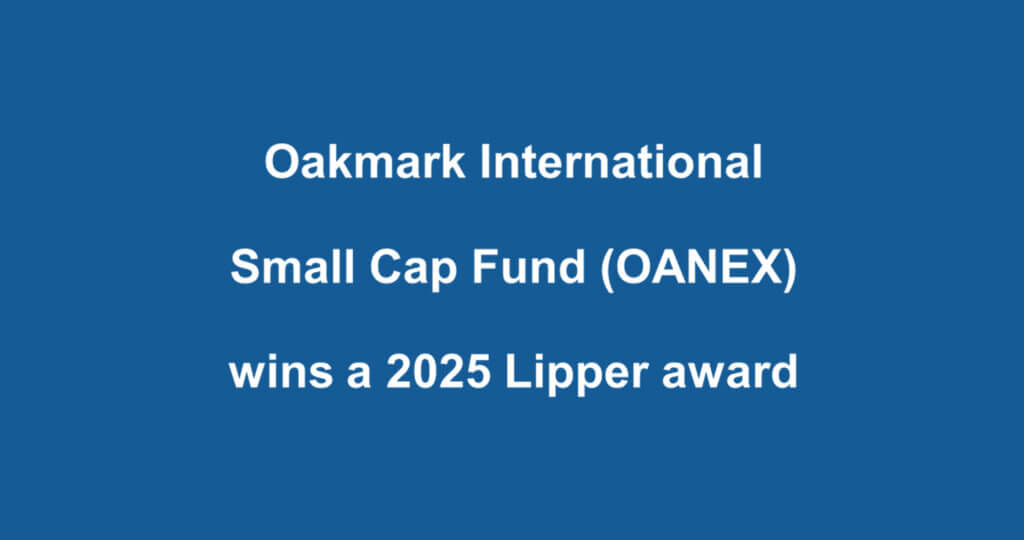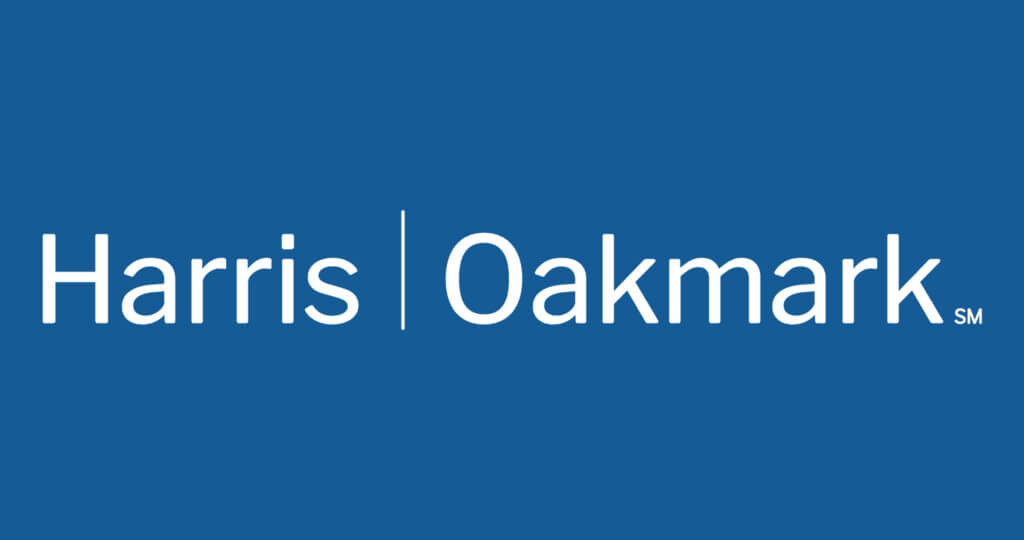Oakmark International Small Cap Fund – Investor Class
Average Annual Total Returns 12/31/21
Since Inception 11/01/95 9.28%
10-year 9.01%
5-year 9.67%
1-year 19.11%
3-month 1.06%
Gross Expense Ratio: 1.39%
Net Expense Ratio: 1.37%
Expense ratios are based on estimated amounts for the current fiscal year; actual expenses may vary.
The net expense ratio reflects a contractual advisory fee waiver agreement through January 27, 2022.
Past performance is no guarantee of future results. The performance data quoted represents past performance. Current performance may be lower or higher than the performance data quoted. The investment return and principal value vary so that an investor’s shares when redeemed may be worth more or less than the original cost. To obtain the most recent month-end performance data, view it here.
The Oakmark International Small Cap Fund returned 1.1% for the quarter ending December 31. The Fund outperformed the MSCI World ex U.S. Small Cap Index, which returned 0.4% for the same period. For the calendar year, the Fund delivered absolute performance of 19.1%, compared to the index’s return of 11.1%. Since its November 1995 inception, the Fund has returned an average of 9.3% per year.
Despite relatively flat performance during the quarter, volatility remained elevated driven mostly by concerns around the Covid-19 Omicron variant. From the variant’s discovery in late November through mid-December, equity prices faltered, but when data suggested that Omicron produced less severe symptoms, the market staged a strong year-end recovery. Due to Omicron’s increased transmissibility, some businesses may still be interrupted over the next quarter or two, but we do not anticipate the variant will significantly affect the intrinsic values of the vast majority of our portfolio companies. Keep in mind the annual cash flow generated in any one year typically represents less than 5% of the intrinsic value of a business we own; therefore, the impact of a quarter or two of disruption is rather de minimis.
For the calendar year, we were pleased with the Fund’s performance on both absolute and relative terms. Strong stock selection in the U.K. (with St James’s Place, SThree, Mitie, PageGroup and Equiniti all generating annual returns above 45%) and a significant underweight exposure to Japan relative to the primary benchmark were the most significant contributors to relative outperformance. Going forward, we remain optimistic about the positioning of the portfolio as we expect economic conditions will continue to improve in 2022. In addition, despite healthy absolute returns over the past year, we believe valuations remain reasonable given the low base from which 2021 began.
Pirelli, a consumer tire manufacturer based in Italy, was a top contributor to the Fund’s performance for the quarter. Pirelli focuses on the premium tire segment of the passenger car and light truck auto market, where it targets 18-inch-and-above specialty tires. This premium market positioning helped drive a strong set of third-quarter results in November, which demonstrated solid pricing power and good volume recovery versus 2020. In addition, results indicated Pirelli’s cost-savings program was progressing on schedule and should deliver additional net benefits to margins through 2022. Management also reiterated the company is capturing 50% more market share in the emerging electric vehicle segment. This is another premium market in which Pirelli can gain distinction since electric vehicles require tires that can handle faster acceleration and greater vehicle weight while also delivering lower rolling resistance and quieter locomotion. Finally, the company managed its working capital effectively during the third quarter and generated significant free cash flow, which can be used for debt reduction and opportunistic shareholder distributions in the future.
Software AG, a German-headquartered business infrastructure software solutions provider, was a top detractor from the Fund’s fourth-quarter performance. In November, the company delivered mixed third-quarter earnings results. Bookings growth within Software AG’s digital business platform (DBP) fell short of management’s guidance, as well as our estimates, as a result of deal slippage and challenges in converting the company’s sales funnel in a timely fashion. However, management indicated more promising DBP bookings growth for the year and observed that the issues were mostly timing-related in nature. In December, Software AG reported that Silver Lake Partners, an American global private equity firm that focuses on technology investments, will be investing in the company and securing two board seats. Although the company’s share price reacted negatively to the news, these changes are intended to accelerate growth, and Software AG is hoping to leverage Silver Lake’s transformation expertise and brand recognition to fuel its merger-and-acquisition strategy.
We initiated two new positions during the quarter:
- TeamViewer (Germany) is a subscription-model software company specializing in cloud-based remote access, remote control, connectivity and enterprise software/device management. We purchased shares of the company at a discount to our estimate of intrinsic value following the release of financial results and medium-term targets that missed analysts’ estimates. Despite this setback, we consider TeamViewer’s business model and competitive position attractive in a market with an appealing growth profile. Additionally, we believe TeamViewer’s strong profitability and cash-flow generation, combined with its expansion into enterprise product suites and its advanced technology, make the company an attractive investment.
- Essentra (U.K.) manufactures components, filters and packaging products. After undergoing multiple restructuring initiatives in the past five years, the company announced in the fourth quarter that it intends to separate its businesses and move to a pure-play components structure. We consider Essentra’s components segment highly valuable and believe it benefits from attractive growth trends and a favorable margin profile. We support management’s decision to unlock shareholder value through the separation and we believe the company is undervalued relative to the sum of its parts.
During the quarter, we sold Medmix (Switzerland) in favor of more attractive investment opportunities. The Fund received shares of the liquid applicators company in the third quarter after a spin-off from Sulzer.
Geographically, we ended the quarter with approximately 71% of our holdings in Europe and the U.K., 12% in Asia, and 8% in Australasia. The remaining positions are 5% in Latin America (Mexico), 3% in North America (Canada) and 1% in the Middle East (Israel). We believe the Swiss franc remains overvalued versus the U.S. dollar, and we ended the quarter with defensive hedges on approximately 15% of the Fund’s franc exposure.
We wish our fellow shareholders a very happy and healthy 2022.
The securities mentioned above comprise the following preliminary percentages of the Oakmark International Small Cap Fund’s total net assets as of 12/31/21: Equiniti 0%, Essentra 0.1%, Medmix 0%, Mitie Group 1.4%, PageGroup 0.7%, Pirelli 2.1%, Software AG 3.0%, St James’s Place 1.8%, SThree 0.7% and TeamViewer 1.5%. Portfolio holdings are subject to change without notice and are not intended as recommendations of individual stocks.
The MSCI World ex US Small Cap Index (Net) is designed to measure performance of small-cap stocks across 22 of 23 Developed Markets (excluding the United States). The index covers approximately 14% of the free float-adjusted market capitalization in each country. This benchmark calculates reinvested dividends net of withholding taxes. This index is unmanaged and investors cannot invest directly in this index.
The Fund’s portfolio tends to be invested in a relatively small number of stocks. As a result, the appreciation or depreciation of any one security held by the Fund will have a greater impact on the Fund’s net asset value than it would if the Fund invested in a larger number of securities. Although that strategy has the potential to generate attractive returns over time, it also increases the Fund’s volatility.
The stocks of smaller companies often involve more risk than the stocks of larger companies. Stocks of small companies tend to be more volatile and have a smaller public market than stocks of larger companies. Small companies may have a shorter history of operations than larger companies, may not have as great an ability to raise additional capital and may have a less diversified product line, making them more susceptible to market pressure.
Investing in foreign securities presents risks that in some ways may be greater than U.S. investments. Those risks include: currency fluctuation; different regulation, accounting standards, trading practices and levels of available information; generally higher transaction costs; and political risks.
The percentages of hedge exposure of each foreign currency are calculated by dividing the market value of all same-currency forward contracts by the market value of the underlying equity exposure to that currency.
The information, data, analyses, and opinions presented herein (including current investment themes, the portfolio managers’ research and investment process, and portfolio characteristics) are for informational purposes only and represent the investments and views of the portfolio managers and Harris Associates L.P. as of the date written and are subject to change and may change based on market and other conditions and without notice. This content is not a recommendation of or an offer to buy or sell a security and is not warranted to be correct, complete or accurate.
Certain comments herein are based on current expectations and are considered “forward-looking statements”. These forward looking statements reflect assumptions and analyses made by the portfolio managers and Harris Associates L.P. based on their experience and perception of historical trends, current conditions, expected future developments, and other factors they believe are relevant. Actual future results are subject to a number of investment and other risks and may prove to be different from expectations. Readers are cautioned not to place undue reliance on the forward-looking statements.
All information provided is as of 12/31/2021 unless otherwise specified.










